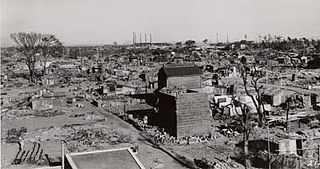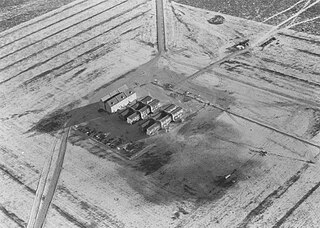 W
WOn 1 November 1944, a United States Army Air Forces (USAAF) F-13 Superfortress conducted the first flight by an Allied aircraft over the Tokyo region of Japan since the Doolittle Raid in April 1942. This photo reconnaissance sortie returned with 7000 photographs which helped with planning air raids on Japan during the last months of World War II. Attempts by Japanese air units and anti-aircraft gun batteries to shoot down the F-13 failed, as the available fighter aircraft and guns could not reach the high altitude at which it operated.
 W
WThe Bombing of Akita in World War II , also known as the Tsuchizaki Air Raid , on the night of August 14, 1945, was part of the strategic bombing campaign waged by the United States against military and civilian targets and population centers during the Japan home islands campaign in the closing stages of World War II. This was reportedly the farthest-range and also the last bombing mission in World War II, coming only hours before Japan announced its surrender.
 W
WThe Bombing of Aomori in World War II on July 28, 1945, was part of the strategic bombing campaign waged by the United States against military and civilian targets and population centers during the Japan home islands campaign in the closing stages of World War II.
 W
WThe Japanese city of Kure, Hiroshima was attacked repeatedly by Allied aircraft during World War II. These raids targeted the major naval base located at the city, ships moored at this base or nearby, industrial facilities, and the city's urban area itself.
 W
WThe Doolittle Raid, also known as the Tokyo Raid, was an air raid on 18 April 1942 by the United States on the Japanese capital Tokyo and other places on Honshu during World War II. It was the first air operation to strike the Japanese archipelago. It demonstrated that the Japanese mainland was vulnerable to American air attack, served as retaliation for the attack on Pearl Harbor, and provided an important boost to American morale. The raid was planned, led by, and named after Lieutenant Colonel James Doolittle, later General of the United States Air Force.
 W
WAbout 8.5 million Japanese civilians were displaced from their homes between 1943 and 1945 as a result of air raids on Japan by the United States Army Air Forces (USAAF) during World War II. These evacuations started in December 1943 as a voluntary government program to prepare the country's main cities for bombing raids by evacuating children, women and the elderly to rural towns. After American bombers started to devastate entire cities in 1945 millions more civilians fled to the countryside.
 W
WThe Bombing of Hamamatsu in World War II was part of the strategic bombing campaign waged by the United States of America against military and civilian targets and population centers of the Empire of Japan during the Japan home islands campaign in the closing states of World War II.
 W
WThe Bombing of Hiratsuka in World War II was part of the strategic bombing campaign waged by the United States against military and civilian targets and population centers during the Japan home islands campaign in the closing states of World War II.
 W
WAllied forces conducted many air raids on Japan during World War II, causing extensive destruction to the country's cities and killing between 241,000 and 900,000 people. During the first years of the Pacific War these attacks were limited to the Doolittle Raid in April 1942 and small-scale raids on military positions in the Kuril Islands from mid-1943. Strategic bombing raids began in June 1944 and continued until the end of the war in August 1945. Allied naval and land-based tactical air units also attacked Japan during 1945.
 W
WJapanese Village was the nickname for a range of houses constructed in 1943 by the U.S. Army in the Dugway Proving Ground in Utah, roughly 100 kilometers (62 mi) southwest of Salt Lake City.
 W
WThe bombing of Kobe in World War II on March 16 and 17, 1945, was part of the strategic bombing campaign waged by the United States against military and civilian targets and population centers during the Japan home islands campaign in the closing stages of World War II. The city would be bombed again in later months.
 W
WThe Bombing of Kōfu in World War II was part of the strategic bombing campaign waged by the United States against military and civilian targets and population centers of the Empire of Japan during the Japan home islands campaign in the closing states of World War II.
 W
WThe bombing of Nagaoka took place on the night of 1 August 1945, as part of the strategic bombing campaign waged by the United States against military and civilian targets and population centers in the Japan home islands during the closing stages of World War II. Between 65.5 and 80 percent of the urban area of Nagaoka was destroyed during the bombing.
 W
WThe Bombing of Numazu in World War II was part of the strategic bombing campaign waged by the United States against military and civilian targets and population centers during the Japan home islands campaign in the closing stages of World War II.
 W
WThe bombing of Okazaki in World War II was part of the strategic bombing campaign waged by the United States against military and civilian targets and population centers during the Japan home islands campaign in the closing states of World War II.
 W
WThe Bombing of Sendai in World War II on July 10, 1945, was part of the strategic bombing campaign waged by the United States against the civilian population and military targets during the Japan home islands campaign in the closing stages of World War II.
 W
WThe Bombing of Shizuoka in World War II on June 19, 1945, was part of the strategic bombing campaign waged by the United States against military and civilian targets and population centers during the Japan home islands campaign in the closing stages of World War II.
 W
WThe Bombing of Tokyo was a series of firebombing air raids by the United States Army Air Forces during the Pacific campaigns of World War II. Operation Meetinghouse, which was conducted on the night of 9–10 March 1945, is the single most destructive bombing raid in human history. Of central Tokyo 16 square miles were destroyed, leaving an estimated 100,000 civilians dead and over one million homeless.
 W
WOn the night of 9/10 March 1945, the United States Army Air Forces (USAAF) conducted a devastating firebombing raid on Tokyo, the Japanese capital city. This attack was code-named Operation Meetinghouse by the USAAF and is known as the Great Tokyo Air Raid in Japan. Bombs dropped from 279 Boeing B-29 Superfortress heavy bombers burned out much of eastern Tokyo. More than 90,000 and possibly over 100,000 Japanese people were killed, mostly civilians, and one million were left homeless, making it the most destructive single air attack in human history. The Japanese air and civil defenses proved largely inadequate; 14 American aircraft and 96 airmen were lost.
 W
WThe Toyohashi Air Raid was a strategic bombing operation on the night of 19 June 1945 against the city of Toyohashi, Japan. The air raid was part of the Allies' aerial campaign against the Home Islands of the Empire of Japan during World War II.
 W
WThe Bombing of Tokokawa in World War II was part of the strategic bombing campaign waged by the United States of America against military and civilian targets and population centers during the Japan home islands campaign in the closing stages of World War II.
 W
WThe XXI Bomber Command was a unit of the Twentieth Air Force in the Mariana Islands for strategic bombing during World War II.
 W
WThe Yahata Steel Works is a steel mill in Kitakyūshū, Fukuoka Prefecture, Japan. Imperial Steel Works was established in 1896 to meet increasing demand from the nation's burgeoning shipbuilding, railway, construction, and armaments industries. The site chosen was the former town of Yahata, now merged into Kitakyūshū, near coal mines and with easy access to the sea.
 W
WThe Japanese city of Yahata was subjected to three major air raids during World War II, part of the U.S. strategic bombing campaign. The first raid took place on the night of 15/16 June 1944. This was the first attack on the Japanese home islands by United States Army Air Forces bombers since the Doolittle Raid of 1942. The city was next attacked during the day and night of 20 August 1944. These two attacks caused little damage to the city's industrial facilities. The third raid was conducted on 8 August 1945 and resulted in 21 percent of Yahata's urban area being destroyed. The third raid may have spared nearby Kokura from destruction, as Kokura was to be the primary target for the second atomic bomb the following day, but smoke from the fires in Yahata combined with cloud cover decreased visibility to the point that the secondary target of Nagasaki was bombed instead.
 W
WThe Bombing of Yawata on the night of 15/16 June 1944 was the first air raid on the Japanese home islands conducted by United States Army Air Forces (USAAF) strategic bombers during World War II. The raid was undertaken by 75 B-29 Superfortress heavy bombers staging from bases in China. Only 47 of these aircraft bombed the raid's primary target, the Imperial Iron and Steel Works at Yawata in northern Kyūshū, and little damage was caused. Five B-29s were lost in accidents during the operation and two were destroyed by Japanese aircraft.